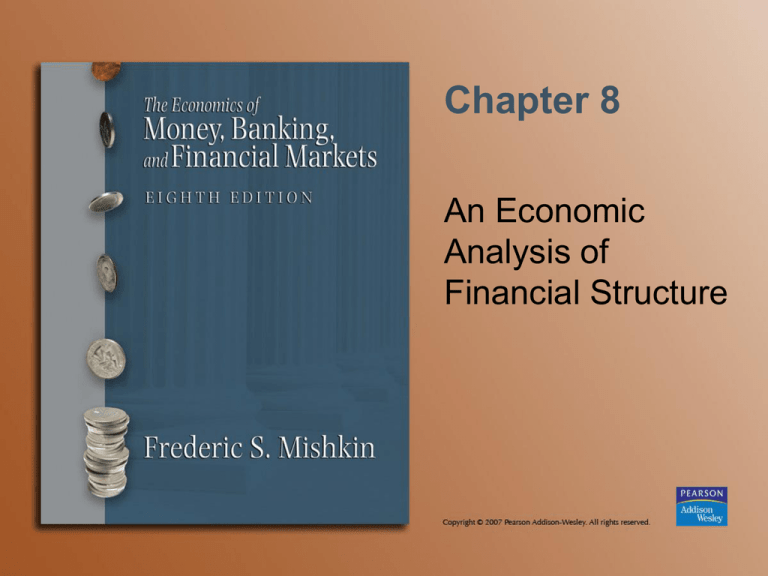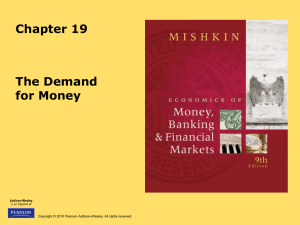
Chapter 8
An Economic
Analysis of
Financial Structure
Copyright © 2007 Pearson Addison-Wesley. All rights reserved.
8-2
Eight Basic Facts
1. Stocks are not the most important sources of
external financing for businesses
2. Issuing marketable debt and equity securities
is not the primary way in which businesses
finance their operations
3. Indirect finance is many times more important
than direct finance
4. Financial intermediaries are the most
important source of external funds
Copyright © 2007 Pearson Addison-Wesley. All rights reserved.
8-3
Eight Basic Facts (cont’d)
5. The financial system is among the most
heavily regulated sectors of the economy
6. Only large, well-established corporations
have easy access to securities markets to
finance their activities
7. Collateral is a prevalent feature of
debt contracts
8. Debt contracts are extremely complicated
legal documents that place substantial
restrictive covenants on borrowers
Copyright © 2007 Pearson Addison-Wesley. All rights reserved.
8-4
Transaction Costs
• Financial intermediaries have evolved to
reduce transaction costs
Economies of scale
Expertise
Copyright © 2007 Pearson Addison-Wesley. All rights reserved.
8-5
Asymmetric Information
• Adverse selection occurs before
the transaction
• Moral hazard arises after the transaction
• Agency theory analyses how
asymmetric information problems affect
economic behavior
Copyright © 2007 Pearson Addison-Wesley. All rights reserved.
8-6
Adverse Selection:
The Lemons Problem
• If quality cannot be assessed, the buyer is
willing to pay at most a price that reflects the
average quality
• Sellers of good quality items will not want to
sell at the price for average quality
• The buyer will decide not to buy at all because
all that is left in the market is poor quality items
• This problem explains fact 2 and partially
explains fact 1
Copyright © 2007 Pearson Addison-Wesley. All rights reserved.
8-7
Adverse Selection: Solutions
• Private production and sale of information
Free-rider problem
• Government regulation to increase information
Fact 5
• Financial intermediation
Facts 3, 4, & 6
• Collateral and net worth
Fact 7
Copyright © 2007 Pearson Addison-Wesley. All rights reserved.
8-8
Moral Hazard in Equity Contracts
• Called the Principal-Agent Problem
• Separation of ownership and control
of the firm
Managers pursue personal benefits and
power rather than the profitability of the firm
Copyright © 2007 Pearson Addison-Wesley. All rights reserved.
8-9
Principal-Agent Problem: Solutions
• Monitoring (Costly State Verification)
Free-rider problem
Fact 1
• Government regulation to increase information
Fact 5
• Financial Intermediation
Fact 3
• Debt Contracts
Fact 1
Copyright © 2007 Pearson Addison-Wesley. All rights reserved.
8-10
Moral Hazard in Debt Markets
• Borrowers have incentives to take on
projects that are riskier than the lenders
would like
Copyright © 2007 Pearson Addison-Wesley. All rights reserved.
8-11
Moral Hazard: Solutions
• Net worth and collateral
Incentive compatible
• Monitoring and Enforcement of Restrictive
Covenants
Discourage undesirable behavior
Encourage desirable behavior
Keep collateral valuable
Provide information
• Financial Intermediation
Facts 3 & 4
Copyright © 2007 Pearson Addison-Wesley. All rights reserved.
8-12
Copyright © 2007 Pearson Addison-Wesley. All rights reserved.
8-13
Conflicts of Interest
• Type of moral hazard problem caused by economies
of scope
• Arise when an institution has multiple objectives and,
as a result, has conflicts between those objectives
• A reduction in the quality of information in financial
markets increases asymmetric information problems
• Financial markets do not channel funds into productive
investment opportunities
• The economy is not as efficient as it could be
Copyright © 2007 Pearson Addison-Wesley. All rights reserved.
8-14
Why Do Conflicts of Interest Arise?
• Underwriting and Research in
Investment Banking
Information produced by researching companies is
used to underwrite the securities. The bank is
attempting to simultaneously serve two client
groups whose information needs differ.
Spinning occurs when an investment bank
allocates hot, but underpriced, IPOs to executives
of other companies in return for their companies’
future business
Copyright © 2007 Pearson Addison-Wesley. All rights reserved.
8-15
Why Do Conflicts
of Interest Arise? (cont’d)
• Auditing and Consulting in Accounting Firms
Auditors may be willing to skew their judgments
and opinions to win consulting business
Auditors may be auditing information systems or
tax and financial plans put in place by their
nonaudit counterparts
Auditors may provide an overly favorable audit to
solicit or retain audit business
Copyright © 2007 Pearson Addison-Wesley. All rights reserved.
8-16
Conflicts of Interest: Remedies
• Sarbanes-Oxley Act of 2002 (Public
Accounting Return and Investor
Protection Act)
Increases supervisory oversight to monitor and
prevent conflicts of interest
Establishes a Public Company Accounting
Oversight Board
Increases the SEC’s budget
Makes it illegal for a registered public accounting
firm to provide any nonaudit service to a client
contemporaneously with an impermissible audit
Copyright © 2007 Pearson Addison-Wesley. All rights reserved.
8-17
Conflicts of Interest:
Remedies (cont’d)
• Sarbanes-Oxley Act of 2002 (cont’d)
Beefs up criminal charges for white-collar
crime and obstruction of official
investigations
Requires the CEO and CFO to certify
that financial statements and disclosures
are accurate
Requires members of the audit committee
to be independent
Copyright © 2007 Pearson Addison-Wesley. All rights reserved.
8-18
Conflicts of Interest:
Remedies (cont’d)
• Global Legal Settlement of 2002
Requires investment banks to sever the link
between research and securities underwriting
Bans spinning
Imposes $1.4 billion in fines on accused
investment banks
Requires investment banks to make their analysts’
recommendations public
Over a 5-year period, investment banks are
required to contract with at least 3 independent
research firms that would provide research to their
brokerage customers
Copyright © 2007 Pearson Addison-Wesley. All rights reserved.
8-19
Financial Crises
and Aggregate Economic Activity
• Crises can be caused by:
Increases in interest rates
Increases in uncertainty
Asset market effects on balance sheets
Problems in the banking sector
Government fiscal imbalances
Copyright © 2007 Pearson Addison-Wesley. All rights reserved.
8-20
Copyright © 2007 Pearson Addison-Wesley. All rights reserved.
8-21
Copyright © 2007 Pearson Addison-Wesley. All rights reserved.
8-22







